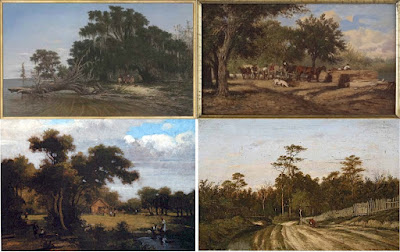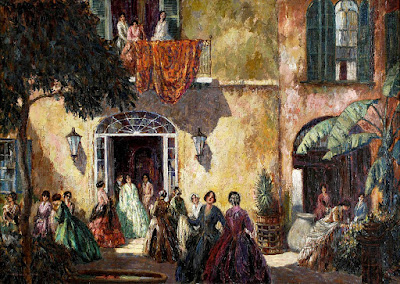In a June 1913 issue of the St. Tammany Farmer newspaper comes this interesting story of "Art in St. Tammany," featuring the critique of an art exhibit at a local bank, the history of the artist Marshall Smith, his education, his bout with typhoid fever, and his Covington recuperation that led to his plans to establish a studio here and teach students everything he knew about art, which was considerable.
Here is the newspaper article about Marshall J. Smith and his time in Covington. It uses the descriptive expression of a cultured art critic, but offers quite a bit of information about the famed Mr. Smith and his background:
Here is the text from the above article:
"Art In St. Tammany
For some days past there has been exhibited at the St. Tammany Bank, an example of Marshall J. Smith's interpretation of Louisiana scenery.
The unique habitation represented therein, a relic of the remote period in the rural districts of our State. The spreading oak, with sombre foliage, its branches festooned by graceful folds of Spanish moss, and tall sentinel cypresses too, well indicate Mr. Smith's knowledge and familiarity with the arboreal life of our semi-tropical forests.
The quiet stream, with its rush-lined banks, its bosom flecked with lily-pads, are all true to the real.
The patient ox team, beneath the "yawning oak," awaiting the "Gee-e-e-e Buck" or "Wh-o-o-a-a-a Brandy" of their master, resting at the base of the oak, are all sights familiar to us.
The very atmosphere pervading, goes to show what a close student of Nature Mr. Smith has been, for only from Here can one receive such impressions and inspirations.
More scenic paintings by Marshall J. Smith
The St. Tammany Farmer article from 1913 continues:
The Scenic Inspirations
"The foreground is strongly treated and smacks of realism. The earth is of "Earth-Earthy," as the furrowed road, incised by ruts, would indicate.
The remote distance is wrapped in a mysterious haze, that is met by the violet-tinge of the heavy atmosphere, overhanging the horizon. The general technique of the little painting a positive, and nothing indicates the "shambling touches" of the less skilled amateur.
Mr. Smith, the creator of the work under criticism, is a true lover of the beautiful scenery in his beloved Louisiana and never tires of expatiating upon its beauty.
It was Richard Clague, his lamented master, who first inspired in Mr. Smith the beauties of our forests, fields, rivers and bayous, and pointed out the picturesque romance of the "Forest Primeval," where the moss-covered trees stood like "Druids of Eld," "with beards that rest upon their bosom."
Clague deceased since 1874 Mr. Smith was sent to Europe, where for many years he studied in the various foreign schools of art. In Rome, under de Montalant, in whose studio he remained while pursuing his studies in the Academy di Medeci from "statuary" and clay, from the "draped" and "nude" at even.
All this time continuing his painting at de Montalant's studio in the "via Margutta," near the Piazza di Spagna. Mr. Smith then prepared himself for entering the Royal Bavarian Academy at Munich.
There he became a matriculated student under Carl Von Piloty's directorship (who succeeded Wilheim Von Kaulbach). After his term in Munich, Mr. Smith returned to Parish, where he studied "The Antique" in the Louvre, returning thereafter to the United States.
Typhoid Fever
A short time prior to coming to Covington, while reaping the harvest of his long studies abroad, Mr. Smith was stricken with typhoid fever, which so undermined his health and impaired his sight that he was forced reluctantly to abandon his brushes... but now that both health and sight are restored, he intends devoting himself to his profession "lending a helping hand and leading the way" to those young aspirants who would crave proficiency in art.
Just as soon as he will have established a studio near the scenes of the Tchefuncta, Bogue Falaya and Abita's borders, he will entertain applications from pupils. "
End of St. Tammany Farmer article.
So in this one article, we have a review of an art exhibit, the descriptions of Louisiana's scenic forest beauty, Mr. Smith's art education background, his European travels, his sickness, his recovery, and his plans to open an art school in the Covington-Abita Springs area.
While apparently Smith did not stay in Covington, he did go on to greater fame in Chicago. An internet search of Artist Marshall J. Smith turns up some additional biographical information.
Marshall J. Smith Well Known
According to the website FineEstateArt.com,
"Marshall Smith located in New Orleans as a child and as an adolescent took art lessons from the dean of the Crescent City art scene, Richard Clague.
"He went abroad in the 1870s, to Munich and Rome for study and toured the broader continent and England.
"Upon his return, Smith worked in the family insurance business and eventually became an insurance broker, painting all the while. He was also a Works Progress Administration artist."
Over on "The Johnson Collection" website, Smith is identified as a "Chicago artist" who spent some time in New Orleans.
According to the Johnson Collection,"Records show that Smith maintained a studio at the Tree Studios, located on one of Chicago’s main thoroughfares. Established by Judge Lambert Tree and his wife Anne in 1894—one year after the city hosted the World’s Columbian Exposition—the studio’s purpose was to entice European artists to return to Chicago. In addition, a collection of eighty-five captioned pen-and-ink cartoons Smith created is held in the Archives of American Art.
"Believed to be a native of Wisconsin, Smith spent time in New Orleans and clearly enjoyed its ambience. He found the city’s streets and courtyards appealing subjects, often rendering them with heavy impasto, earth tones, and dramatic lighting. On occasion, he populated these scenes with individuals nostalgically dressed in nineteenth-century style."
So his stopover in Covington helped him recover from typhoid fever, and enabled him to continue his art education and make a name for himself in the art world. After he left Covington he apparently went back to Europe and returned to New York from La
Havre, France, in September, 1926. From there it was on to Chicago.
A Courtyard in New Orleans by Artist Marshall Joseph Smith
See also:
Tammany Landscapes Attract Artists
Richard Clague, Founder of the Louisiana landscape painting tradition





